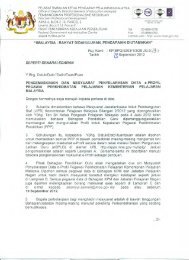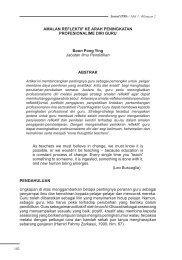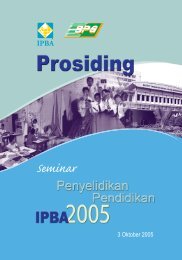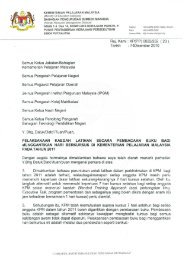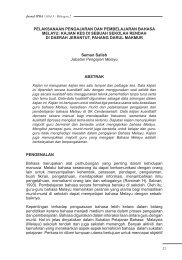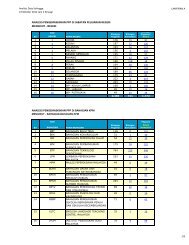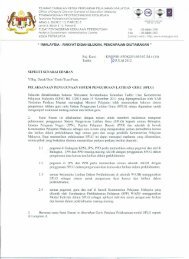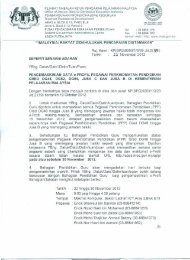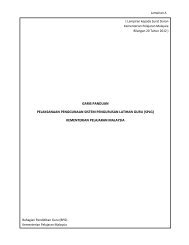The Level of Burnout among IPBA Lecturers
The Level of Burnout among IPBA Lecturers
The Level of Burnout among IPBA Lecturers
Create successful ePaper yourself
Turn your PDF publications into a flip-book with our unique Google optimized e-Paper software.
urnout by Farber (1984) and Maslach and Jackson (1981) namely, burnout is the final<br />
step in a progression <strong>of</strong> unsuccessful attempts to cope with negative stress conditions<br />
and that burnout can be seen from three aspects <strong>of</strong> subscales, that <strong>of</strong> emotional<br />
exhaustion, depersonalization and personal accomplishments (Aeria, 1995).<br />
<strong>The</strong> subscale <strong>of</strong> emotional exhaustion burnout refers to feelings <strong>of</strong> physical and<br />
emotional exhaustion and ennui as a result <strong>of</strong> daily work pressures and time constraints.<br />
Depersonalisation burnout occurs as a result <strong>of</strong> the incessant interactions <strong>among</strong> helpers<br />
(for example, lecturers) and clients (for example, students) and this form <strong>of</strong> burnout<br />
is categorized by the development <strong>of</strong> negative attitudes and impersonal responses<br />
towards the people with whom one works closely. Personal accomplishments burnout<br />
indicates a loss <strong>of</strong> self- esteem and work accomplishment as a consequence <strong>of</strong> limited<br />
positive feedback and recognition (Maslach & Jackson, 1981).<br />
<strong>Level</strong> <strong>of</strong> <strong>Burnout</strong><br />
Respondents indicated their level <strong>of</strong> agreement to each <strong>of</strong> the 22 items in the Maslach<br />
<strong>Burnout</strong> Inventory (MBI) based on an 8 point Likert rating scale, a ‘1’ indicates very<br />
mild or untrue while a ‘7’, very strong or true. <strong>The</strong> respondents score ‘0’ (zero) if the<br />
feeling or attitude described is never experienced.<br />
<strong>The</strong> total <strong>of</strong> the scores is then summed up according to the three subscales. <strong>The</strong><br />
level <strong>of</strong> burnout is then determined by the mean obtained for each subscale as shown<br />
in Table 1. <strong>The</strong> range <strong>of</strong> experienced burnout has been categorized following that <strong>of</strong><br />
Aeria’s categorization <strong>of</strong> MBI scores.<br />
Table 1: Categorization <strong>of</strong> MBI mean<br />
Note: Items on personal accomplishment have been reversed-scored<br />
Source: Adapted from Aeria (1995).<br />
As can be seen from Table 1, if a respondent obtained a mean <strong>of</strong> 4.00 or less for the<br />
Emotional Exhaustion (EE) subscale, then he is deemed to experience a low level<br />
<strong>of</strong> burnout. A mean <strong>of</strong> above 4.33 indicates that the respondent experiences a high<br />
burnout level for EE. Note that the means for the range <strong>of</strong> experienced burnout level<br />
varies between the subscales.<br />
39




